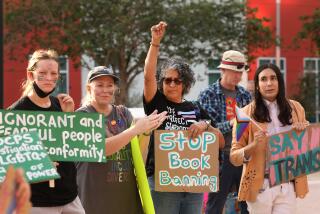For a quarter-century, he dominated California’s courtrooms,...
For a quarter-century, he dominated California’s courtrooms, defending wife-killers and lawyers more famous than himself.
So great was his renown that murderers clamored “Get me Earl Rogers!” Fans at ballgames would shout at ballplayers arguing with the umpire: “Go ahead and kill him, we’ll get you Earl Rogers.”
His celebrity clients included the fabled Clarence Darrow, a Los Angeles police chief and the philanthropist-scoundrel Col. Griffith J. Griffith, who shot his wife in the eye but atoned by giving Los Angeles a mammoth park.
Rogers also considered himself a defender of lost--or strayed--sheep, and pleaded on behalf of whores, pimps and robbers. At a time when murderers were routinely executed, he did not believe in the death penalty and he clung to his minister-father’s belief that justice should serve the poor.
Before the advent of television and radio, Angelenos packed the courthouse and read every word printed about Rogers’ often tawdry cases. He introduced innovative cross-examination styles and trailblazing courtroom pyrotechnics.
He was a genius, a showman, the son of a Methodist minister. At the University of Syracuse in New York, he played football and met Hazel Belle Green, whom he married three times and with whom he had four children.
*
In 1894, after their first child, Adela, was born, they moved to Los Angeles. Fascinated by the law, Rogers soon became the protege of Stephen White, the famous attorney and U.S. senator who became instrumental in establishing the harbor at San Pedro.
Both men had a lot in common: a bottomless capacity for knowledge and booze. White liked Rogers’ quick mind and style.
Their friendship would break up in court. Soon after Rogers began practicing in 1897, he defended an unemployed plumber accused of murdering a popular young lawyer named Jay Hunter over a $4 plumbing bill. White was working for the prosecution.
Rogers won, stunning the city and his onetime mentor; for the first time, White had been beaten in court. And upon the “Little Giant’s” fall, Rogers rose to glory.
Rogers’ immaculate appearance--spats, monocle and a different suit each day, set off by a gardenia in his lapel--played to his flamboyant image.
His reputation and stature soon towered over others; he was earning more than $100,000 a year in the second decade of the century. He rarely took cases that he thought were sure losers, but he saw ways to win cases that others had written off.
In the 77 murder cases he argued, only one defendant ever hanged. And most--as even Rogers admitted--were probably guilty. After one man was acquitted of murdering his wife, he turned to Rogers and said: “The truth will prevail, Earl.” Rogers snarled: “Get away from me, you slimy pimp! You know you’re guilty as hell.”
In 1906, Rogers was persuaded for the first time to switch roles and assist the district attorney in prosecuting Morrison Buck, the former chauffeur of Los Angeles oil magnate Charles A. Canfield. Buck had asked Canfield for a loan of $2,600, but when Canfield refused, he shot Canfield’s wife, Chloe, twice in the head. The defense tried to prove Buck was insane, but Rogers proved he was sane and Buck hanged.
Yet Rogers’ victory filled him with a remorse that never healed. Only seconds after Buck was pronounced dead at San Quentin, Rogers wailed: “We’re all wrong. . . . Who are we to take life? . . . I can’t forgive myself.”
When attorney Darrow was accused of bribing the jury during his defense of J.B. McNamara in the bombing of the Los Angeles Times in 1910, Darrow hired Rogers to defend him. Darrow was acquitted.
But as Rogers’ career soared, his personal life was reduced to shambles. All three of his stormy marriages to Hazel Belle ended in divorce.
His heart mended quickly after he met Edna (Teddy) Landers, a tall, redheaded Irish-Canadian with a beautiful singing voice. In 1916, she gave up her Roman Catholic faith to marry Rogers, who was almost twice her age. Their fairy tale marriage ended three years later, when she died in the worldwide influenza epidemic at the age of 29.
From that point, the drinking problem that had plagued him grew worse.
When he was not in court defending the downtrodden, his influential friends had been in court defending him, mostly because of his drinking. His famous journalist daughter, Adela, spent much of her life perpetuating Rogers’ legendary reputation as a legal tactician, bon vivant and uncommon drunk.
His drinking accelerated with the guilt he carried for sending Buck to the gallows.
Finally, Rogers sank into drunken irresponsibility. His eldest son signed a complaint to have him committed, and Adela appeared in court against him. When her direct testimony was ended, Rogers--defending himself this time--approached the witness box. He asked softly: “You don’t think I’m crazy, do you, honey?”
Adela burst into tears and the complaint was dismissed.
After that, Rogers was in and out of hospitals until he was found dead in 1922 at age 51 in his room at the New Broadway Hotel on Bunker Hill between 1st Street and Temple--a block from the courthouse.
More to Read
Sign up for Essential California
The most important California stories and recommendations in your inbox every morning.
You may occasionally receive promotional content from the Los Angeles Times.









